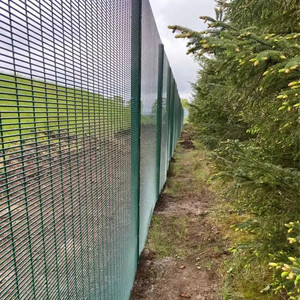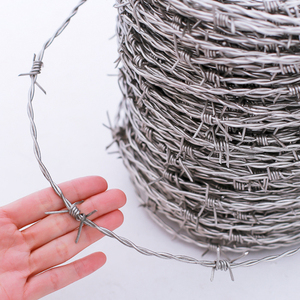(88 products available)




















































































































































































Jail fences are security barriers used in prisons and correctional facilities. They are designed to prevent escapes, control inmate movement, and enhance overall security. Here are some key points about jail fences:
Jail fences are crucial for maintaining order and safety within correctional facilities. They must be built and maintained to meet the necessary security standards.
Vertical Fines:
The vertical bars are the key elements of a vertical jail fence. These bars are typically made from strong materials like steel or heavy-duty wrought iron. They are placed closely together, with very little space between them, to ensure that no one can squeeze through. These bars give the fence its strength and durability, making it hard for anyone to break in or out.
Top Rail:
A top rail connects the vertical bars at the top of the fence. This top rail not only keeps the vertical bars steady and in place but also adds extra protection. The top rail helps prevent anything from falling over the fence and makes it harder for anyone to climb over.
Bottom Rail:
Like the top rail, the bottom rail is important for the fence's stability and security. The bottom rail keeps the vertical bars steady and prevents anyone from digging under the fence. Together with the vertical bars, the bottom rail makes the fence strong and safe for everyone inside and outside.
Gates:
The gates of a jail fence are like doors that allow people and things to come in and go out safely. These gates are made just as strong as the rest of the fence so that no one can break through them easily. Special locks are used on the gates to keep them secure and only allow authorized people to open them.
Security Features:
To keep everyone safe, jail fences have extra security features. One such feature is barbed wire, which is sharp and dangerous. Barbed wire is placed at the top of the fence to stop anyone from trying to climb over. Another security feature is the anti-climb spikes, small sharp points attached to the top of the vertical bars. These spikes make it very hard for anyone to grab the top of the fence and pull themselves up.
Materials:
Jail fences are built to last a very long time and withstand outside weather like rain, snow, and sun. That's why they are made from tough materials. Most jail fences are constructed using steel or heavy-duty wrought iron because these materials are very strong. Steel and iron can handle being bumped into without getting damaged. They also last longer when exposed to bad weather. For even more protection against rusting or corroding, jail fences can be made using galvanized materials. This means coating the steel or iron with a special protective layer to keep it in good shape for many years. Fences in places that get wet or have extreme weather use aluminum or stainless steel to ensure they don't wear out quickly. All these materials are picked carefully so that jail fences remain safe and secure for a very long time.
Safety and security
Jail fences make sure people inside a jail are safe. They stop inmates from escaping and keep staff and visitors safe. High fences and special features stop inmates from leaving the jail grounds.
Control and order
Jail fences help staff control the inmates. Fences and gates keep inmates in their areas and help staff know where they are. This order is important for running the jail smoothly and safely.
Prevention of incidents
Jail fences stop fights between inmates and help prevent riots. They create clear borders between different inmate groups, reducing chances for violence or tension to happen. Fences also keep out weapons and other dangerous items that could help with escapes or fights.
Containment during emergencies
If there is an emergency like a riot or natural disaster, jail fences help keep inmates contained. Strong fences stop inmates from leaving their areas during these times when control is very important. This protects both inmates and staff until the situation calms down.
Psychological barrier
The high and secure jail fences create a psychological barrier for inmates. It reminds them that they are being watched and limits their freedom. This can affect how they behave inside. It also helps staff maintain order by making sure everyone knows where the boundaries are set between different groups within a correctional facility.
Perimeter security
Jail fences are part of the perimeter security system. Along with cameras, lights, and alarms, these metal barriers help secure the outside area of a jail. They work together to keep inmates inside and unauthorized people out, so all those inside remain safe from outside threats while preventing anyone from escaping.
Separation from society
The main purpose of jail fences is to separate inmates from society. By building strong walls around correctional facilities, courts can legally keep convicted criminals away from law-abiding citizens. This separation also allows for rehabilitation programs within jails where offenders can learn new skills before returning back into public life.
Purpose and Function:
The first step in choosing a jail fence is to determine its purpose and function. Is the fence meant for a minimum-security facility, a medium-security facility, or a maximum-security facility? Different levels of security require different types of fences. For example, a minimum-security facility may require a fence that is not easily climbable and has no sharp spikes on top, while a maximum-security facility may require a fence that is difficult to penetrate and has anti-dig features.
Materials:
Jail fences are usually made from durable materials such as steel or concrete. Steel is commonly used because it is strong and can be easily molded into various shapes. Concrete is also used because it can provide a solid barrier that is difficult to breach. When selecting materials for a jail fence, factors such as durability, maintenance requirements, and cost should be considered.
Height and Visibility:
The height of a jail fence is crucial in preventing escapes and ensuring security. The taller the fence, the harder it is for inmates to climb over. However, height alone does not guarantee security; visibility must also be considered. A visible fence allows guards to see what is happening near the perimeter, which deters inmates from attempting to escape and prevents unauthorized people from entering the prison grounds.
Anti-Climbing Features:
Anti-climbing features should be included in the design of jail fences to prevent inmates from scaling them. These features can take the form of barbed wire or razor wire on top of the fence, anti-climb mesh panels, and cantilevered arms that make it difficult for inmates to climb over.
Materials:
Jail fences are usually made from durable materials such as steel or concrete. Steel is commonly used because it is strong and can be easily molded into various shapes. Concrete is also used because it can provide a solid barrier that is difficult to breach. When selecting materials for a jail fence, factors such as durability, maintenance requirements, and cost should be considered.
Installation:
Jail fences must be installed properly to function as intended. This involves following the manufacturer's instructions and guidelines during construction and ensuring that all components are securely fastened and aligned. Additionally, it may be necessary to conduct regular inspections and maintenance of the fence to ensure its continued effectiveness and longevity.
Q1: What is the purpose of a jail fence?
A1: A jail fence provides security, privacy, and containment for inmates within a correctional facility.
Q2: What materials are commonly used for jail fences?
A2: Most jail fences are made from durable materials like galvanized steel, chain link, and concrete to ensure they last long and are cost-effective.
Q3: How high should a jail fence be?
A3: The height of a jail fence depends on the level of security needed, but it should always be tall enough to prevent inmates from escaping or outsiders from getting in.
Q4: What are the different types of jail fences?
A4: Some common kinds include chain link fences, welded wire fences, barbed wire top fences, and electrified perimeter fences.
Q5: Can jail fences be customized?
A5: Yes, jail fences can be tailored to meet the specific requirements of a correctional facility.